Alberto Giacometti: un minimalismo “avant garde” | Alberto Giacometti: a minimalism "avant garde"
Uno de los más importantes artistas del siglo XX, Alberto Giacometti, falleció el 11 de enero de 1966. Fue un expresivo pintor y dedicado escultor. Nació en Suiza, pero gran parte de su vida la pasó en Francia. Su práctica creativa estuvo influenciada en un tiempo por el cubismo y el surrealismo, dos resaltantes corrientes de la vanguardia artística europea, aunque quizás su obra se identifique más con una búsqueda expresionista.
En vida recibió muchos reconocimientos de individualidades, como los elogios a su obra por el máximo representante del surrealismo, André Breton, por el artista Salvador Dalí, el escritor Jean Genet y el filósofo existencialista Jean-Paul Sartre. También premios institucionales, tal el Gran Premio a la Escultura de la Bienal de Venecia en 1962. Y ha sido muy cotizada, alcanzando los más altos niveles de venta en importantes subastas.
***
One of the most important artists of the 20th century, Alberto Giacometti, died on January 11, 1966. He was a painter and dedicated sculptor. He was born in Switzerland, but much of his life was spent in France. His creative practice was influenced at one time by cubism and surrealism, two outstanding currents of the European artistic avant-garde, although perhaps his work is more identified with an expressionist search.
During his lifetime he received many recognitions from individuals, such as the praise of his work by the maximum representative of surrealism, André Breton, by the artist Salvador Dalí, the writer Jean Genet and the existentialist philosopher Jean-Paul Sartre. Also institutional awards, such as the Grand Prize for Sculpture at the Venice Biennale in 1962. And it has been highly valued, reaching the highest levels of sale at important auctions.
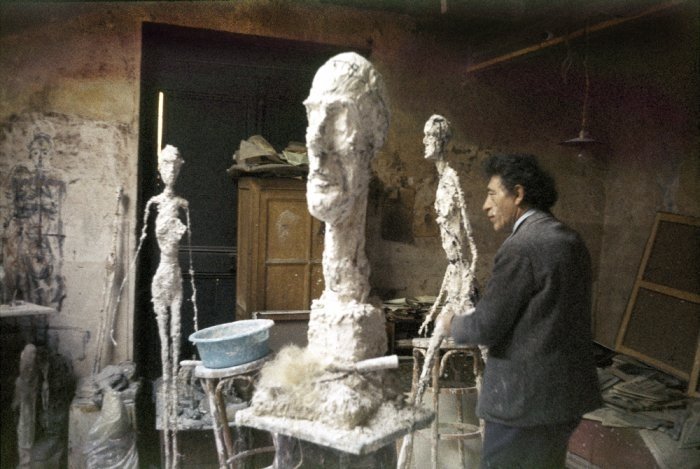
Se ha interpretado la obra pictórica y escultórica de Giacometti como una manifestación vital e intelectual frente a la soledad y el aislamiento del hombre moderno, sometido a las duras realidades de su tiempo histórico y existencial. Por ello se le ha asociado al existencialismo sartriano, más cuando Sartre expresó en alguna oportunidad que Giacometti era el existencialista perfecto, entre el ser y la nada.
No parece haber duda de que su creación artística está tocada centralmente por esas crisis existenciales, que lo convirtieron en un hombre retirado del mundo, casi encerrado en su taller. Pero, hubo además una búsqueda formal de gran relevancia, acentuada en su proceso artístico, pero que podría identificarse de cierta manera en sus primeros trabajos reconocidos. Me refiero a una búsqueda esencialista, que, marcada por su expresionismo, irá despojando a sus figuras, particularmente en la escultura, de referencias de tiempo y espacio, de “anécdota”, como él mismo puntualizó. De allí que se pueda pensar en un minimalismo adelantado (“avant garde”), pues como sabemos esta tendencia se instaura a partir de los años 60.
Desde mi apreciación, ya en su famosa “Bola suspendida”, de 1931 (comprada, por cierto, por André Breton), puede percibirse esa tendencia a lo esencial y despojado:
***
Giacometti's pictorial and sculptural work has been interpreted as a vital and intellectual manifestation in the face of the loneliness and isolation of modern man, subjected to the harsh realities of his historical and existential times. That is why he has been associated with Sartre's existentialism, especially when Sartre once said that Giacometti was the perfect existentialist, between being and nothingness.
There seems to be no doubt that his artistic creation is centrally touched by those existential crises, which turned him into a man withdrawn from the world, almost locked up in his studio. But there was also a formal search of great relevance, accentuated in his artistic process, but which could be identified in a certain way in his first recognized works. I am referring to an essentialist search, which, marked by his expressionism, would strip his figures, particularly in sculpture, of references to time and space, of "anecdote", as he himself pointed out. That is why we can think of him as an advanced minimalism ("avant garde"), since, as we know, this trend was established in the 1960s.
In my opinion, already in his famous "Suspended Ball" of 1931 (bought, by the way, by André Breton), this tendency to the essential and stripped down can be perceived:
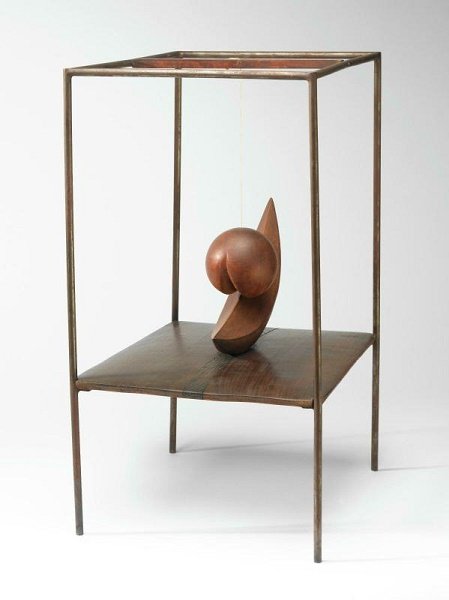
Será a partir de finales de la década del 30 cuando Giacometti comience a desarrollar en su escultura esa construcción minimalista, a nuestro modo de ver, donde trabaja, como precisa el crítico Miguel Calvo Santos,
figuras humanas alargadas, extremadamente delgadas y de una superficie rugosa, áspera. (…) seres humanos (…) de extremidades muy largas, que parecen hechos sólo de piel y huesos.
Sartre llegó a decir que sus esculturas parecían espectros salidos del campo de concentración de Buchenwald, “pero que miradas despacio, la percepción cambiaba y recordaban a formas etéreas que suben al cielo”.
El mismo Giacometti hablará de estatuas “filiformes”, y había reconocido su interés en el arte de Egipto, África y Oceanía; seguramente, tuvo alguna influencia de ese sustrato antropológico y artístico. En ellas se encarnará esa visión despojada, minimista, reducida a la materia esencial, casi ascética, de lo humano que definirá la trascendencia de su obra, que ha llegado a influir a varios artistas posteriores, como Adam Riches y Daisei Terazono.
A continuación, reproduzco fotos de cinco de sus más importantes esculturas de su etapa de la década del 40 en adelante.
***
It will be from the end of the 1930s when Giacometti begins to develop in his sculpture that minimalist construction, in our view, where he works, as the critic Miguel Calvo Santos points out,
elongated human figures, extremely thin and with a rough, rough surface (...) human beings (...) with very long limbs, which seem to be made only of skin and bones.
Giacometti himself will speak of "filiform” statues, and had recognized his interest in the art of Egypt, Africa and Oceania; surely, he had some influence from that anthropological and artistic substratum. In them is embodied that stripped-down, minimalist vision, reduced to the essential, almost ascetic matter, of the human that will define the transcendence of his work, which has come to influence several later artists, such as Adam Riches and Daisei Terazono.
Below are photos of five of his most important sculptures from his period from the 1940s onwards.
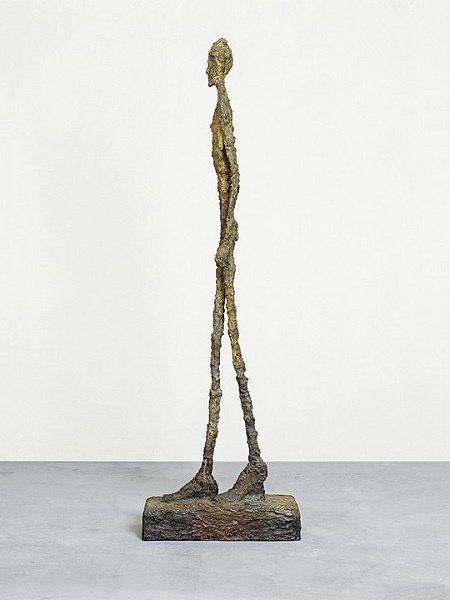


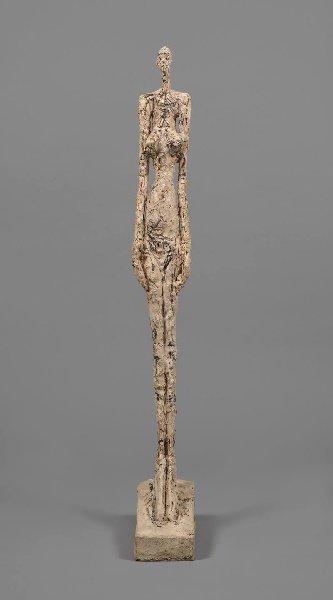
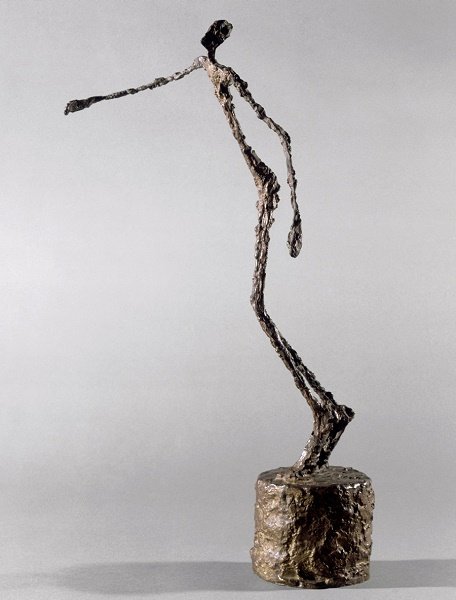
Referencias | References:
https://es.wikipedia.org/wiki/Minimalismo
https://en.wikipedia.org/wiki/Minimalism
https://historia-arte.com/artistas/alberto-giacometti
https://www.abc.es/cultura/arte/abci-giacometti-genio-puso-dieta-escultura-siglo-201810190216_noticia.html
https://www.alejandradeargos.com/index.php/es/completas/8-arte/41488-giacometti
https://www.fondation-giacometti.fr/en

Gracias por su atención. | Thank you for attention.



https://twitter.com/1584249800207253506/status/1613965901790937089
The rewards earned on this comment will go directly to the people sharing the post on Twitter as long as they are registered with @poshtoken. Sign up at https://hiveposh.com.
Saludos, no lo conocía, me parece bien interesante su historia y lo que comentas en el post, investigaré un poco más sobre él.
Gracias por compartir.
!HUESO
!PIZZA
Haz click sobre el banner, para ser dirigido al Discord de Mundo Virtual y conocer más sobre nuestro proyecto de curación.
Click on this banner, to be directed to the Virtual World Discord and learn more about the curation project.
Gracias por la visita. Te recomiendo que lo conozcas, así como a otros tantos artistas capitales del siglo XX. Saludos, @osomar357.
I gifted $PIZZA slices here:
@osomar357(2/5) tipped @josemalavem (x1)
Learn more at https://hive.pizza!